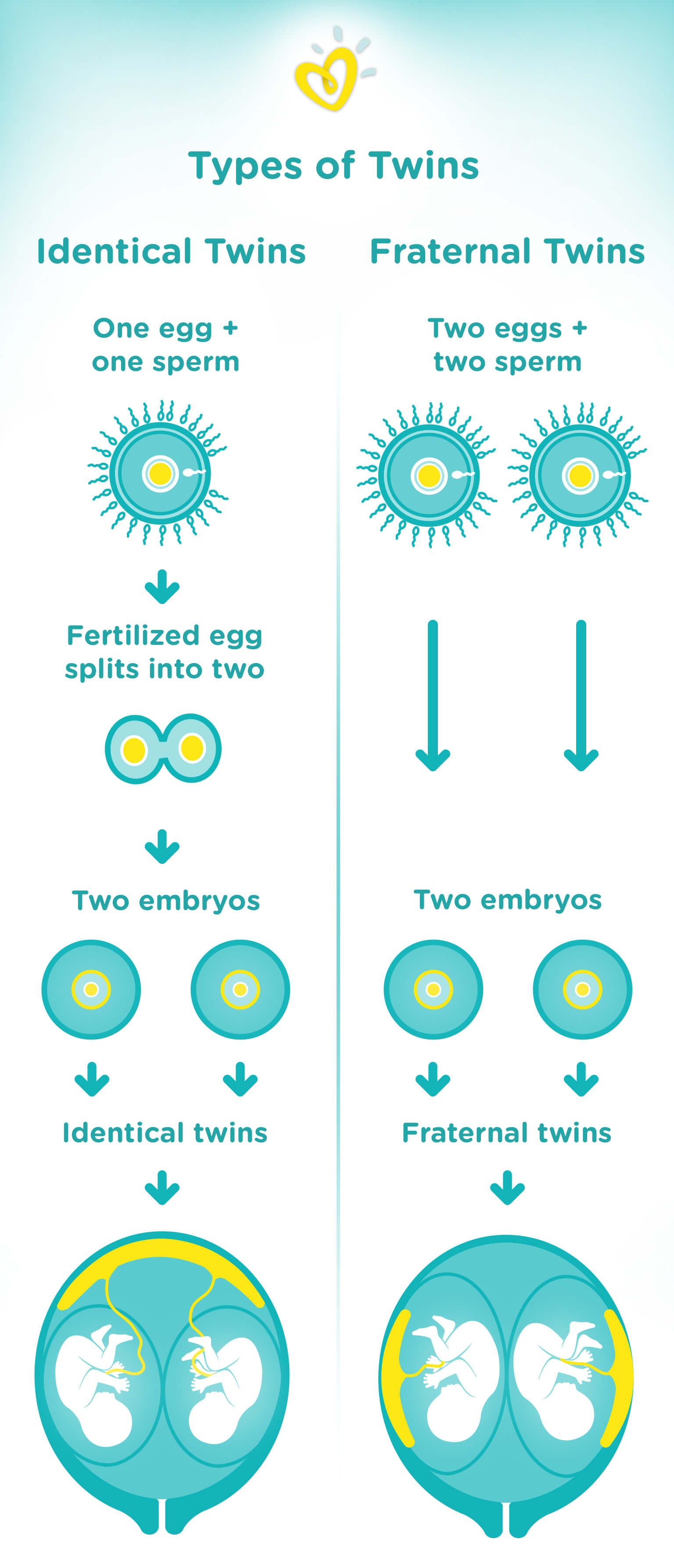Finding out you’re having a baby is one of the most exciting times in your life. Finding out you’re expecting two babies is double the joy — and maybe twice as many questions, too! For example, you might be wondering about all the different types of twins, and what the difference between fraternal and identical twins is.
Read on to find out all this and more, including how some of the different types of twins are formed.
Keep in mind that we won’t cover all of the different types of twins in this article, but will look at some of the most common ones, such as fraternal twins and identical twins.
Fraternal Twins (Dizygotic)
Fraternal twins, which are also called dizygotic twins, are the result of two separate eggs being fertilized by two separate sperm. This can happen because the ovaries release two eggs and not just one.
Basically, fraternal twins are as alike as siblings would be — in other words, they are not identical. Fraternal twins might be two boys, two girls, or a boy and a girl. Each baby develops in his or her own placenta.
Identical Twins (Monozygotic)
Identical twins, or monozygotic twins, form when one fertilized egg splits in two and grows into two separate embryos. The twins are the same gender, share the same blood type, and share the same physical traits. Identical twins may or may not share one amniotic sac.
One of the most common questions asked is “Do identical twins have the same DNA?” They actually do have the same DNA at birth but eventually the DNA becomes more distinctive based on environmental factors. This is how each twin evolves to be a unique individual. For more on your little one’s development, check out what happens week-by-week during a twin pregnancy.
Conjoined Twins
In some rare cases, the embryo only partially separates, and the two fetuses remain partially connected as they grow. Conjoined twins can connect at different spots, including the chest, abdomen, or hips. The twins may also share one or more internal organs. Sadly, many conjoined twins do not make it to full term or live only a short while after birth. Conjoined twins who do survive are sometimes successfully separated by surgery.
Do Twins Share a Placenta and Amniotic Sac?
Sometimes twins share the placenta (the organ that connects mother to baby), amniotic sac (the inner membrane), and chorion (the outer membrane), and sometimes they each have their own. Your healthcare provider will be able to explain which of these is relevant for your pregnancy, and what it might mean for your pregnancy and babies.
Diamniotic-dichorionic Twins
These types of twins have their own chorions and amniotic sacs, but they may or may not share the same placenta.
Diamniotic-monochorionic Twins
These types of twins share a chorion and a placenta but are in separate amniotic sacs.
Monoamniotic-monochorionic Twins
These types of twins share a chorion, placenta, and an amniotic sac. This is the rarest type of twin, and it means a riskier pregnancy as the babies can get tangled in their own umbilical cords. If you have monoamniotic-monochorionic twins, your healthcare provider will monitor your pregnancy closely.
How Common Is Having Twins?
Multiple births — which include twins, triplets, quadruplets, and more — have become more common in recent years because more couples are turning to fertility drugs and IVF treatments to help them conceive. In the United States, twins account for about 3 percent of live births.
Getting pregnant over the age of 30, being a twin yourself, or having a family history of twins on the maternal side can also increase your chance of having twins.
If you’ve just found out you’re pregnant with twins, read more about twin pregnancy and what to look forward to, and use our Due Date Calculator to get an estimate of when you might meet your little ones.
FREQUENTLY ASKED QUESTIONS
- What are the most common types of twins?
Fraternal twins, which are not identical twins, are the most common type of twins.
- How do you tell what type of twins you are having?
Your healthcare provider might offer an ultrasound, which might help determine the type of twins you are having.
- Can twins be identical if they are in different amniotic sacs?
Yes, identical twins can have separate amniotic sacs.
- Do twins have to run in the family for you to have them?
You’re more likely to have twins if you yourself are a twin, or if twins run in your family on the maternal side. However, you don’t have to have a family history of twins to be pregnant with twins yourself.
- What’s the difference between identical and fraternal twins?
Identical twins form when a fertilized egg splits in two; fraternal twins happen when two separate eggs are fertilized by two separate sperm. Fraternal twins are as similar as siblings are; identical twins share many common traits including gender, blood type, and physical appearance.
Although the biology behind twins can be tricky to completely understand, just know that having multiple babies is a miracle of nature. No matter what kind of twins you’re having, you’ll cherish those first few weeks with your twins, and the many milestones to come in the months and years beyond.
Keep in mind that with twins you’ll be on double diaper duty, so why not earn double the rewards for all those diapers? Download the Pampers Club app, and receive rewards like coupons, cash back, and gifts for all your Pampers purchases.




